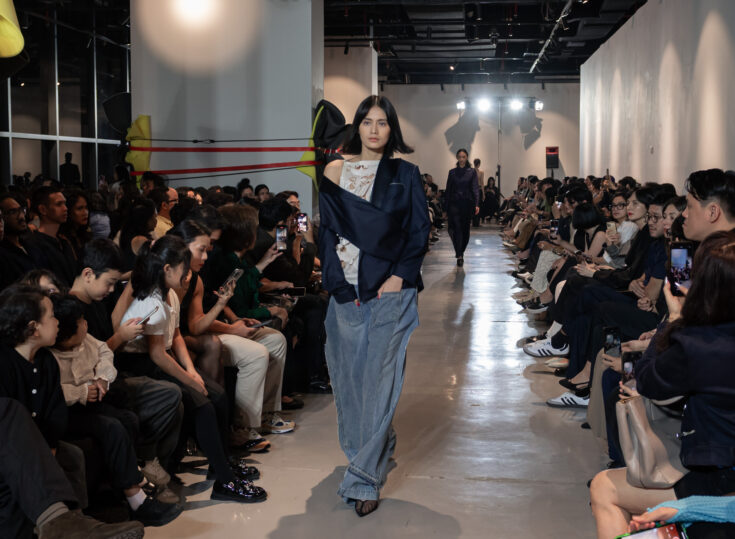In our effort to make social distancing less monotonous, REMOTELY is a special series from Manual Jakarta where we roll out comforting and practical articles to keep you company and motivated during this period of self-isolation.
–
The lifestyle industry is put on pause as the world continues its battle with COVID-19. To gauge the scope of its severity across different sectors, few major events have been either postponed or cancelled: from the 2020 Olympics and the annual Met Gala to the Cannes Film Festival, a collective effort was made to slow down the pandemic from spreading.
This new reality also sinks in for the fashion industry worldwide. For one, having the situation escalated amid Fashion Week has warranted prompt actions such as cancelling major runway shows and closing physical stores. What follows is the inevitable economic impact of such drastic moves.
Alas, brands and retailers are left with no choice but to come up with a game plan and fast. In these moments, big questions such as how does the pandemic affect the business and what does the future hold for them, are always asked. But what do designers and retailers really feel about a situation of this magnitude?
The unforeseen
It was only in February when Major Minor, an Indonesian fashion label, was in Paris for their Autumn/Winter Showroom presentation. But in a matter of weeks, the label started to see the consequences of the pandemic.
In March alone, they had to cancel their show at the Plaza Indonesia Fashion Week 2020 (which was postponed until further notice) and a launching project with MASARISHOP. In addition to that, the brand’s sales period was cut in half, along with buyers asking for extended payment deadlines and naturally, a delay in production and delivery.
“In fashion, you cannot expect anything to hold, regardless of the circumstances,” says Anna Francesca Marcesar, a rep from the label. “Many brands and businesses are experiencing the same thing. It will take a lot of effort to get through this pandemic.”
The same goes for RAITO, whose biggest blow has been with their supply chain. When the pandemic broke out earlier this year, the contemporary eyewear brand was certain of the impact it will bring to their 2020 collection launch. “Most of our hardware and finishings are customised in China and Hong Kong, so we were certain that our manufacturers would be affected,” says Hermawan Chandra, co-founder of the label.
With the pandemic reportedly contained in both countries, the brand’s manufacturers have started to get back to work, according to Hermawan. But the challenge now lies on the other end of the chain. “With the rest of the world being affected, logistic companies are reducing their services, along with stockists and consumers limiting their consumption.”
For Sejauh Mata Memandang, the impact of the pandemic also led to the postponement of their scheduled events, like the Senayan City’s Fashion Nation XIV Edition and the Plaza Indonesia Fashion Week in March. But as a sustainable fashion brand, whose backbone is the local craftsmen and artisans, the first step has always been to prioritise their health and safety. “Our production is still running, but we prioritise [products] that can be made from home as we have implemented the work-from-home policy for our workers,” says Talitha Kandou, a rep from the label.
Just like Sejauh, the same preventive measures are also applied to the workers at Major Minor and RAITO. Though the latter has always been familiar with the concept of working-from-home, it’s important for the team to truly understand the situation and stay vigilant. And while this particular safety measure isn’t feasible for production, Major Minor has introduced the work-shifts practice to limit the number of workers at their Jakarta workshop.
Off to online
In times like these, it’s only natural for brands to turn to digital means. Local sustainable brand Sukkhacitta wrote a lengthy post on their website on how the pandemic is affecting their workforce (local artisans), and informing ways to protect them. While Niniveh Space turned semi-online by releasing an e-catalogue for shoppers to browse through. But with this kind of urgency, the pressure to shift online bears more weight than before.
“We had to change our direction and shift our marketing focus more on digital platforms and increasing online distributions,” says Hermawan of RAITO. “We offered our stockists more marketing support to promote their online presence as most of them closed down their bricks and mortar shops (temporarily).” Likewise for both Major Minor and Sejauh Mata Memandang, who have opted to further their online and social media marketing strategies to keep sales somewhat on track.
TOTON, an Indonesian fashion label, also moved to online retail (with stockists ARA and MASARISHOP) ever since COVID-19 became a national emergency. Before then, the label also had to postpone their show for the F/W 2020 collection in Jakarta. Although the shift to online is fairly intuitive these days, this move also presents a new discouraging challenge for the label: no demand.
This is because, for Toton Januar, co-founder of the label, the need for fashion seems rather insignificant with the current climate. “We’re yet to see in the next couple of months, but the picture seems rather bleak for now,” says Toton. “People will focus more on the essentials and fashion, especially entry-level luxury such as our brand, will fall way back in terms of priorities. True creativity will be challenged where we have to find a way to survive but still staying true to our brand ethos.”
A collective act
The good news is, fashion labels worldwide are lending a helping hand during these coronavirus closures. From donating to creating masks and surgical gowns, business owners are stepping up to fill the need.
Over in the local scene, Major Minor and Sejauh Mata Memandang have also made ways to give back. At Sejauh, the label is donating all sales of their handmade face masks to WeCare.id, a non-profit organisation, for the purchase of medical-grade masks, which will be distributed to hospitals. “This mask was initially made to address the city’s pollution, but with the ongoing pandemic, we plan to keep producing them so that people won’t have to buy the medical ones,” says Talitha.
With the same reason, Major Minor has also donated 1000 cloth face masks (and possibly more in the future) to medical front-liners and those in need, by utilising unused fabrics from their factory. “This is one of the ways we practice more sustainable practices,” says Anna of Major Minor. “People have been talking about sustainable fashion for a long time – maybe this is the chance we have to re-evaluate our progress so far and to do things right.”
Safeguarding the business
Put simply, the pandemic has changed the course of the fashion retail landscape. With such a vague situation, brands and retailers could benefit from important insights that could help jolt some order back to their operations, for example, data-driven information to inform their contingency plans.
According to the recent report “Fashion Retail & the COVID-19 Crisis” by Omnilytics, a leading retail data platform from Singapore, common issues faced by fashion brands as a result of the crisis are social distancing in the workforce, supply chain bottleneck, low sales and inventory issues, operational setbacks, consumer demand shifts and marketing communication – issues that aforementioned labels also addressed.
To protect the company, staff and customers, Omnilytics suggests for brands to develop a tactical response plan for each issue to resolve it effectively. Activating the appropriate guidelines for daily operations, implementing remote working and activating social media-driven strategies are some of the suggested immediate actions that a lot of brands have been conducting.
This report also details the actionable steps to tackle the most critical areas of retail and how a data retail platform can empower brands’ contingency plans. Case in point, if the crisis has forced brands to move their inventory offline to online, Omnilytics can help analyse the performance of competitors within the specific market. If brands are looking to diversify sales channels to include online marketplaces and e-commerce sites, the platform can help identify the right online channel or marketplace to partner with.
A response checklist, along with a proposed timeline and actions is included in the report to support designers and retailers in planning their contingency strategies. Backed by real-time market data and data-driven insights, Omnilytics’ tactical response report can be helpful for businesses during this trying time.
What the future looks like
With so much uncertainty in the waters, fashion brands can only hope that this emergency model would last as long as possible, a view shared by Hermawan of RAITO. For Major Minor, this situation is, in turn, testing the label’s ability to adapt. “If we can improve the online aspects of our business (from marketing to sales), meanwhile reduce our carbon footprint and maintain employees’ wellbeing – these are all positive takeaways from a difficult situation,” says Anna.
But in hindsight, this pause also asks what the pandemic reveals about the fashion industry. A recent report by Fortune revealed that the crisis has resulted in millions of factory workers, mostly women in rural areas, being sent home without wages or severance pay they are owed. In a recent Instagram story post, Sukkhacitta also lamented at the current reality of workers being laid off as the impact of the pandemic, imploring business owners to hold on to their workforce and stop the ripple effect.
While this lull may be seen as an opportunity to re-organise, the effect caused by the pandemic has also urged those in the industry to think about what can be done to improve the condition once the situation clears; whether it’d be improving the wellbeing of workers or doing better for the planet.
“The world will never be the same again after the pandemic, and we will be forced to think differently,” says Toton. “Once and for all, we need to truly understand our place in this world and stop acting like we own the place. We don’t. We’re just one of many passengers and we need to learn to respect other beings and live with them in harmony.”
The Bahasa Indonesia version of the Omnilytics’ report can be accessed here. If you’d like to learn more about the best industry practices and crisis management strategies necessary during the COVID-19 pandemic, contact Omnilytics.







